We’re debating about a day trip from Sofia to Rila Monastery because it’s a 2 to 2 ½ hour bus trip each way (120 K) but various friends have encouraged us to go and the photos are certainly encouraging. It’s also a World Heritage site. We also want to go to Boyana Church in the suburbs of Sofia. After a search on the Internet I find a company called Traventuria offering a day trip including both destinations for 25 euro per person, which is an attractive price. I check out Trip Advisor and the fact that the coach drivers are reputed to be careful cinches it for me.
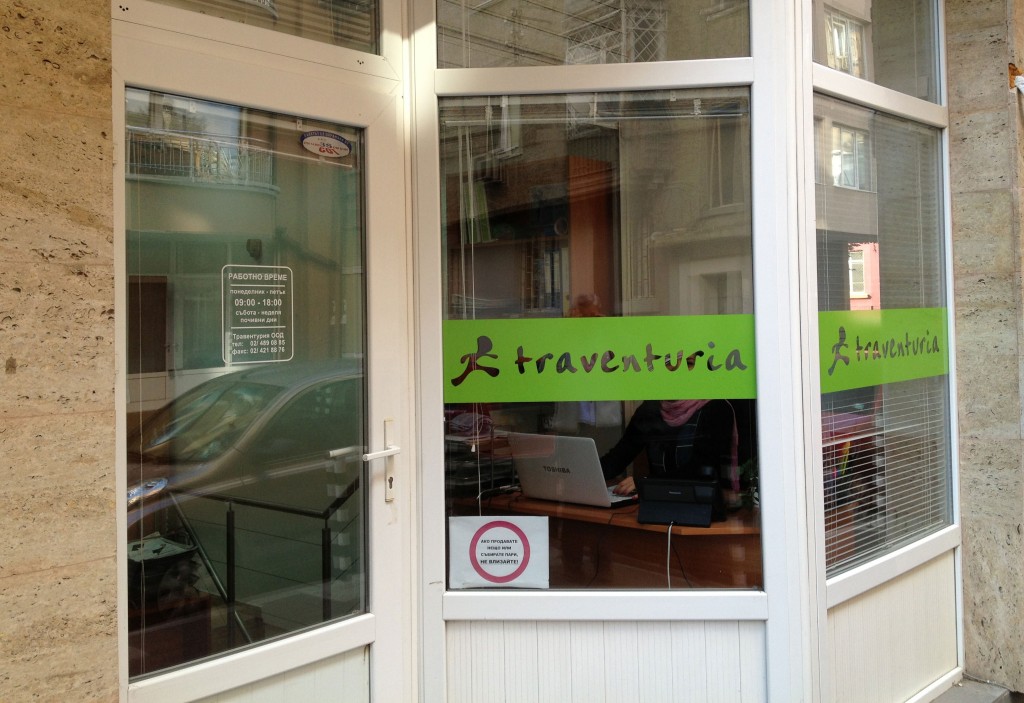
As I start booking, I notice the address at the bottom of the screen. Unbelievably, it’s the same address as ours – their office is on the ground floor of our home exchange building in Veslets Street. We decide to go and pay in cash next morning. The girl is very friendly, speaks excellent English and even gives us an aluminium water bottle each.
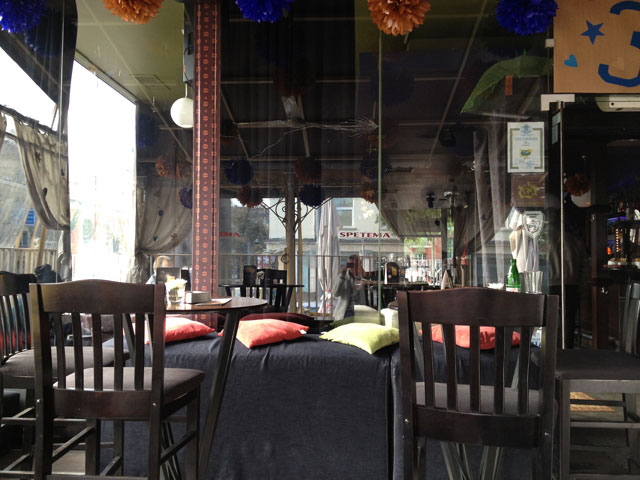
We set off at 8.15 to be well in time for our 9 am rendez-vous behind Nevski Cathedral. Sofia is quite different at that hour, we discover, with everyone hurrying to work. We have time for a coffee at a trendy bar called Spetema just opposite the university.
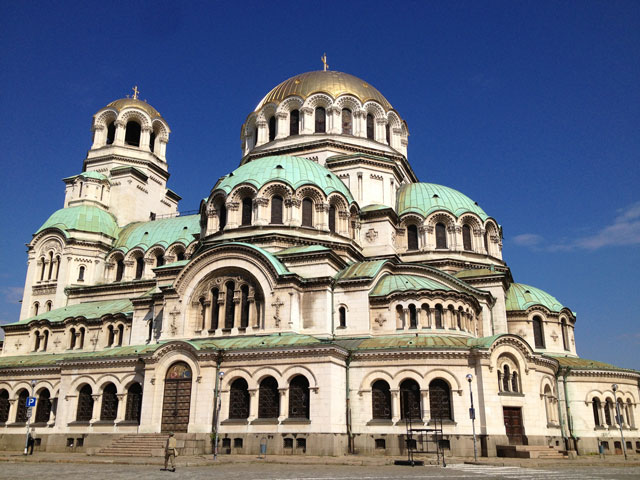
Our 12-seater mini-bus pulls up on time but we wait for a couple of people who never come and finally move off at 9.15 am. There are eight of us altogether. Our young guide tells us the programme: a two-hour drive with a ten-minute rest-stop on the way, two hours at Rila, then back towards Sofia and Boyana where we stop for half an hour. We’ll be back in Sofia by 5 pm.
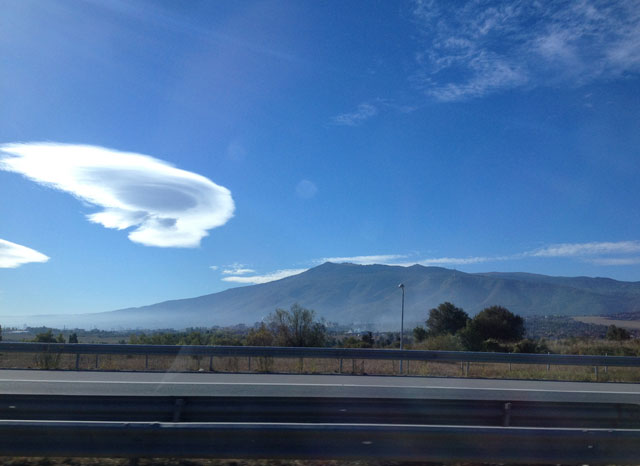
We’re soon on a recent 4-lane highway going at a reasonable pace. I’m reassured. The countryside looks surprisingly like Australia, minus the gum trees. There is little agriculture and only a few weedy looking cows. The cloud formation is quite unique. Jean Michel says there must be a lot of wind. The sky is a deep blue.
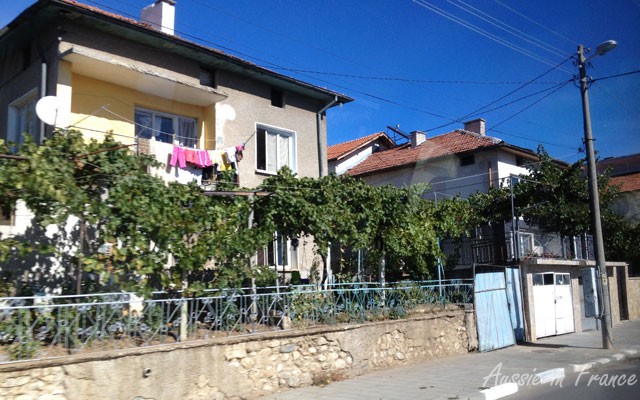
After our rest-stop, we soon turn left and begin circumnavigating Rila Mountain, before making the ascent. I’m amazed at how many houses in the villages have grape vines. The monastery is 1147 metres above ground level (the highest peak on Rila is 2925 metres). We go through mountain forest most of the time. The driver is going quite slowly and I’m not afraid.
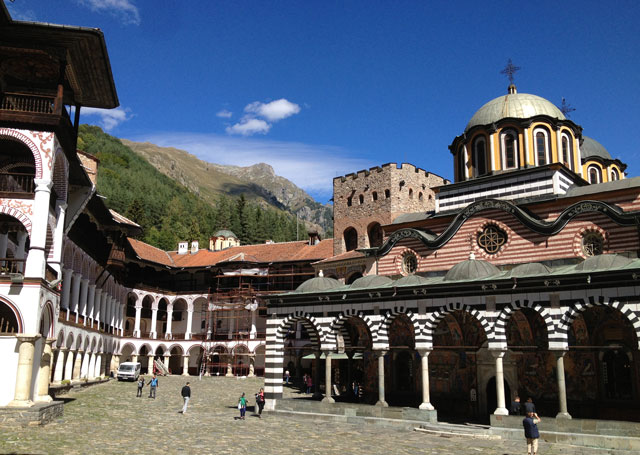
At the top, he pulls up and we get out. The initial impression is quite fabulous and we are not disappointed with the rest of our visit. We expected more people, but are pleasantly surprised to see that if we wait long enough, we can take photos without tourists in brightly coloured clothing taking photos of each other.
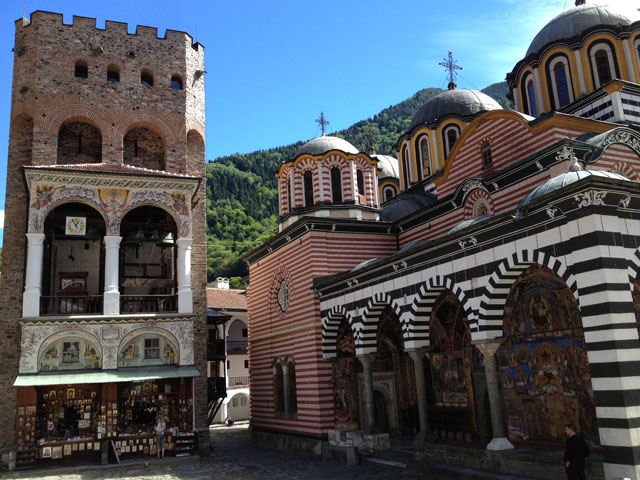
Jean Michel finds a booklet in French and we track down all the things to see because it’s a bit tedious to translate my audio-guide. Rila was founded in the 10th century by the hermit St John of Rila. It was destroyed by fire in the 19th century and rebuilt between 1834 and 1862 and is a characteristic example of the Bulgarian Renaissance (18th-19th centuries), symbolising the awareness of a Slavic cultural identity following centuries of occupation.
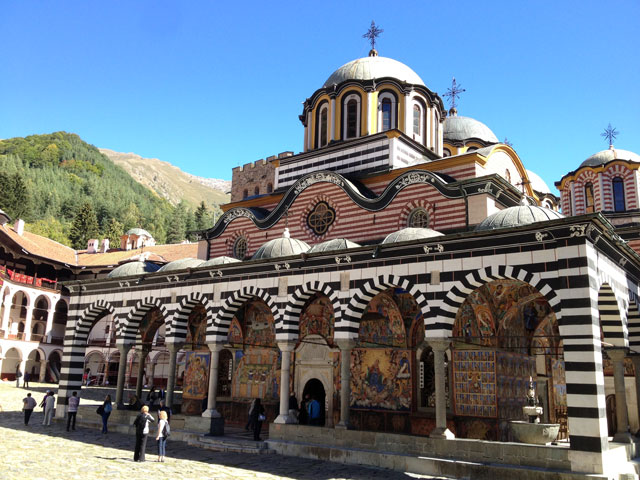
At the end of our visit, there are still three things on the list we haven’t seen, one in the koprivchtitsa room, one in the priory and the other in the tower chapel. We ask in the religious shop and are told to inquire at the museum which we have already visited and contains the most fabulous carved cross I’ve ever seen (81 x 43 cm) by a monk called Rafail, with 104 religious scenes and 650 miniature figures and 12 years in the making. Hardly surprising that Rafail lost his sight in the process. No photographs allowed however.
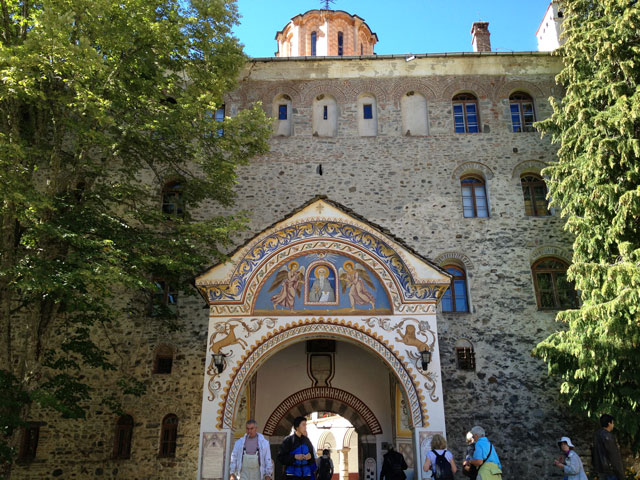
First, we are told no, then the lady at the cash desk picks up her phone, puts it down again and says “30 minutes”. By that time our mini-bus will have left. Disappointed we didn’t ask earlier, we go and wait for our bus which soon appears.
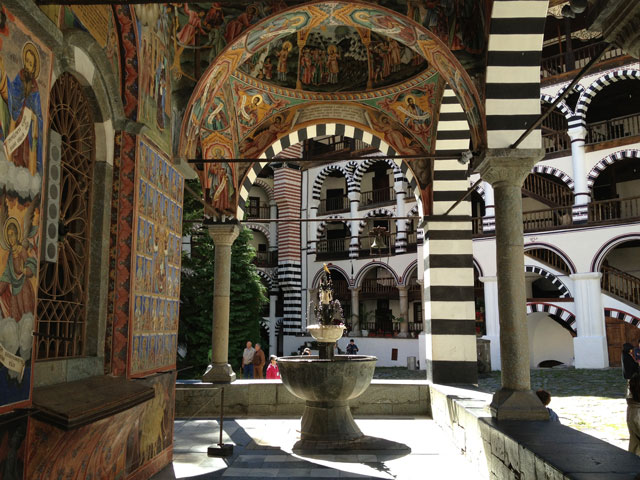
One and a half hours later, our guide tells us we are nearing Boyana Church and that two large coach-loads are expected. If we want to get in before them (only 12 people are allowed in the church at a time for a maximum of 15 minutes), we have to hurry. He collects our entrance fee (10 lev per person) and when we arrive, he buys our tickets and takes us down to the little church.
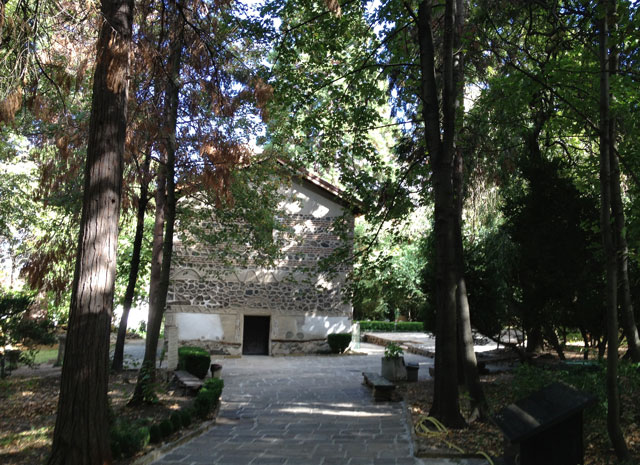
There are three churches, each joining onto the other, built in the 10th to 11th, 13th and early 19th centuries. The frescoes are all from the 14th century. To quote a UNESCO review of this World Heritage site, those painted in 1259 “possess a rare freedom, realism, harmony in the proportions, liveliness and warmth that already foresaw the birth of the Italian Renaissance. The site is one of the most complete and perfectly preserved monuments of east European mediaeval art.”
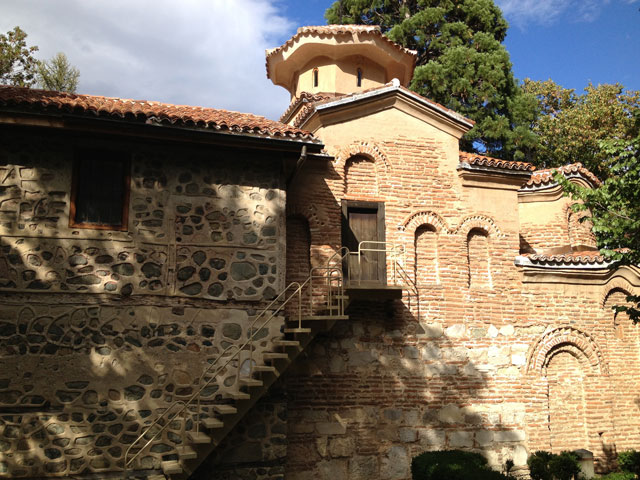
The faces are extremely expressive and the figures include Sebastocrator Kaloyan and his wife Desislava who commissioned the 13th century extension and the frescoes. Our party didn’t choose a guided visit, but I definitely recommend you to do so. As usual, photos of the interior were not allowed, but the website Pravoslavieto has excellent illustrations and descriptions.
This is definitely our best day in Bulgaria so far.
Traventuria Ltd., 45 Veslets Str., 1202 Sofia, BULGARIA, 0035924890884 (Monday – Friday, 08:30 – 16:30 CET), Fax: 0035924917352, www.traventuria.com, info@traventuria.com If you have enjoyed reading this, don’t forget to subscribe to new posts using the subscription form on the top right – that way you’ll get them directly on your smart phone or in your mail box! And I love to hear your comments!



Hi
I recently started receiving your emails.
Thank you for taking the time to share your trip to Bulgaria. I know absolutely nothing about it and have really enjoyed reading about it.
Regards Crawford
Hi Crawford, thank you for commenting. Before we went to Sofia, I tried to find more detailed information and photos on the city and they all seemed to be the same – the Nevski and Sofia churches – so I wanted to fill that gap. I still have to write about Plovdiv where we met up with our home exchange hosts and their daughter which made our stay in Bulgaria much more enriching.
Fascinating! What would you call the architectural style? Moorish Italianate with a touch of Romanesque thrown in for good measure? Are all the interiors painted or is some of it mosaic? Such a shame no photos allowed. Did they indicate why? (My guess is either security or because photographers cause bottlenecks.)
What a terrific coincidence with the tour company!
I’m not so surprised that everyone has vines. Bulgarian wine is excellent (the reds anyway). We used to buy it from time to time in London.
And I’m going to be naughty and point out that you have fallen into a false friend trap, using ‘fastidious’ in the French sense, not the English. Tedious is the word you are looking for
Thanks, Susan, I got rid of the fastidious! I think I use that quite often …
I’m not convinced the word is really “Renaissance”. Revival might be more appropriate but Renaissance is what’s used in the Unesco description. It’s an amazing combination, isn’t it?
The churches inside are usually completely covered with murals, frescoes, icons and iconostases. I don’t remember seeing tiling anywhere in fact. Some of the murals in Boyana, the later ones, if I remember correctly, were tempura.
I think photography is forbidden for religious reasons. It’s the priests that suddenly appear from nowhere and say “no photos”. It seemed disrespectful to insist. We were free to take them in the art gallery, for example.
Sounds lovely – I’ll keep this in mind if ever I get there!
I am not surprised this was your best day in Bulgaria. You stayed at the worst part of the city, where illegal immigrants, gypsies and some poor old women live- difficult to find worse than that, or ok- the gypsy ghetto is worse. When you said in your previous posts that on Vitoshka people are dressed differently- well, yeah, those are the average, normal people ;), the illegals, gypsies and the rest of the people at your place are at the bottom of society, it is hard to expect from them to dress well, to keep clean around their place (it is great if they even have a job)
It is interesting to see how choosing the bad neighbourhood can completely drive you out of the real city life. I am passing to the next blog posts about Plovdiv, let’s see how you perceived the clean, charming, and renewed city
I certainly agree that if we’d been staying in the centre of Sofia we wouldn’t have had the same initial impressions, but that was our experience. However, as I said, Sofia grew on us with time and maybe we needed the initial impresssion to help us appreciate the city as a whole. Stay tuned for Plovdiv!
It certainly ranks among my favourites.